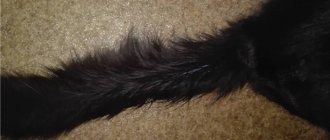Causes of fistula in cats
A fistula can form in a cat after surgery.
According to their origin, fistulas are divided into:
- acquired, appeared in the process of life;
- congenital - formed as a result of a violation of intrauterine development.
The fistula canal of a congenital fistula is lined with normal and healthy mucous cells, while secretions from the internal environment of the body are released from the fistula opening. The nature of the discharge depends on the location of the through hole itself, for example, it could be urine, saliva, bile, feces, etc.
Acquired fistulas are formed as a result of:
- penetrating or through wounds - in this case, wounds can appear both due to external influences (wound with a piercing object, gunshot wound) and as a result of tissue damage in the internal environment of the body; for example, in case of a bone fracture, when part of the fragment cuts through the skin from the inside;
- unintentional tissue damage during surgery;
- development of a purulent inflammatory process with necrosis of surrounding tissues in the deep layers of the skin; A striking example is a fistula in the oral cavity as a result of inflammation of the dental canal due to advanced caries or periodontal disease.
In addition, fistulas can appear due to improper, prolonged treatment of an abscess, boil and other skin diseases.
Causes
The cause of a fistula is often trauma, chronic inflammation, or abnormal intrauterine development.
Depending on the cause of formation, fistulas are:
- Acquired - appear after injury, surgery, development of purulent processes. For example, pathology can occur after sterilization of a cat due to improper use of antiseptics, or with advanced periodontal disease with the subsequent development of an abscess. Other causes of acquired fistula are gunshot wounds, necrotic bone fragments after a complex fracture.
- Congenital - occur as a result of abnormal intrauterine development. The canal is covered with epithelium, and biological fluid leaks through the hole - bile, saliva, urine. Common congenital fistulas include the umbilical one. It appears when the birth is performed incorrectly, or when the animal bites the umbilical cord too close. Penetration of infection through such a channel threatens the development of serious health problems in the kitten.
Prevention measures
Prevention of fistulas involves regular medical examination of animals. After all, a disease noticed in time has every chance of being cured. In case of injury and fractures, care must be taken to ensure that the wounds heal completely and that the fractures heal without complications.
It is necessary to take measures to ensure that the cat’s body resistance is at a high level. This is facilitated by high-quality cat food, enriched with vitamins and microelements, a calm environment, active games, and timely control of parasites. After all, a strong immune system is a reliable protection against many ailments and unpleasant complications.
Treatment of fistula in a cat
It is impossible to cure a fistula, even with the help of the best and most expensive healing ointments. The only way to save your pet from suffering is surgery. It is carried out in several stages. Firstly, it is necessary to eliminate the source of inflammation, which is located deep in the tissues or organs of the animal. All dead tissue and foreign elements are removed.
Fistula in a cat can only be cured surgically.
Important. Such an operation should be carried out under completely sterile conditions so as not to introduce a new infection into the wound.
Next, for better outflow of purulent or fecal fluids, an additional drainage channel is made or a rubber tourniquet is inserted into the cleaned fistula. All granulation formations are removed from the fistula canal using a special spoon with sharp edges. After this, the fistula cavity is washed with some disinfectant (vodka, potassium permanganate or chlorhexidine).
Various healing ointments (Levomekol, Vishnevsky ointment, Dioxidin, etc.) are introduced into the canal treated in this way. Often a specialist will prescribe a course of antibiotic injections. After the source of inflammation is removed and the release of pathological fluids from the canal stops, the entire upper layer is cut out and the hole itself is sutured.
It is clear that you cannot cure such a disease on your own, at home. Only a highly qualified specialist can perform an operation and prescribe anti-inflammatory and restorative therapy.
Treatment of fistula
To begin a full treatment of fistulas in cats, a diagnosis is required that establishes the cause of the problem. After this, the necessary therapy is prescribed. Various methods are used for this .
- Cleansing tissues of foreign objects that caused deep inflammation and the formation of a fistula, and removing dead tissue and sanitizing the inflammatory cavity. This treatment is surgical and performed under general anesthesia. Next, the canal is regularly treated with antiseptic agents until complete healing. Treating the canal every day is a prerequisite for its healing.
- Restoring the correct outflow of physiological fluid through natural pathways or a specially created drainage hole, and not through a fistula. After this, the pathological canal is cleaned and sutured. The fistula will not heal with diseased tissue.
- Removal of wound tissue in the fistula canal using a special instrument - a surgical spoon. This is required if the inflammation that caused the fistula has already passed, but it does not heal due to the pathological tissues lining its canal. For healing to occur, the cat's fistula canal must be clean.
- Introduction through the channel into the site of inflammation of drugs that stimulate tissue healing. This action is necessary when the fistula occurs due to injury. Often in this case, the cavity is not purulent, and the body simply does not have enough strength to heal it. Usually owners of old cats, or those seriously weakened by some chronic disease, encounter this phenomenon. Therapy in this case can last quite a long time.
- Suturing the fistula. It is performed on congenital canals that are covered with healthy epithelium. To do this, if there is inflammation, it is treated with medications. Next, the healthy epithelial layer in the canal is removed and stitched using a special technique. There are no relapses with this form of fistula. The recovery period for a cat after such an operation is minimal.
© shutterstock
In some cases, a decision is made not to touch the fistula. This is possible if the animal’s condition is very poor and anesthesia is contraindicated for it, and the fistula can be maintained in satisfactory condition with the help of medications. Typically, this decision is made regarding old cats suffering from cancer. A veterinarian will give advice on how to treat a fistula at home in such a situation.
Fistula in a cat: types and treatment
The insidiousness of many diseases of our domestic animals is that their external manifestations are not visible in all cases. Of course, the cat may have a decreased appetite, he may be lethargic and apathetic, but most often one can only guess about the reason for such changes. So a fistula in a cat is an unpleasant phenomenon, but it is a more or less pronounced symptom, by which one can already judge the primary disease (and prescribe therapy).
What it is
In medical terminology, the disease is called a kind of channel that connects the animal’s skin to the body. If you look at it externally, the wound is very similar to an open abscess: a large hole where pus mixed with blood constantly oozes. The smell is the same characteristic as with an abscess.
A cat may develop a disease in the following cases:
- Innately. In this case, the problem arises even during intrauterine development, for example, when the mother had a hole in the navel, which connected the fetus to the abdominal cavity.
- Acquired. The disease may appear, for example, after surgery. So, this will indicate that the doctor did not comply with all antiseptic safety measures for the animal. The disease may also appear after improper treatment of the animal by the owners.
This disease does not pose any threat to life, but you should be wary of the fact that dangerous microorganisms can penetrate through the formed channel. Cats in which the disease has occurred near the anus should be under special supervision, since there is a high probability of contracting sepsis and other more serious diseases.
fistula in a cat
The disease in a cat can be classified into different forms. So, depending on how the canal walls are formulated, the disease can be divided into the following types:
- epithelized. In this case, the channel is even and smooth. Hair may constantly fall out around the wound, which indicates skin irritation;
Epithelized fistula in a cat
granulation. For this type, the characteristic loose walls and edges will have an irregular shape that extend beyond the wound itself.
You can also make a classification by location:
- Perianal fistula in a cat. It is considered the most dangerous type of disease, since the animal will have an abscess under its tail. The danger is that this type of disease can often develop into fecal peritonitis.
- Purulent. The location of this disease usually occurs on the cheek, paw, chin and other places. This type of disease is also called simple, since there are no major consequences from it.
And, of course, you can distinguish them based on the reasons for their occurrence. So, if this is a congenital disease, which is very rare, then the cause is intrauterine problems in the cat.
If this is an acquired fistula, then the reasons for its occurrence may be the following factors:
- wounds (penetrating or through);
- tissue damage during surgery, for example, a fistula after sterilization of a cat;
- complications of the purulent and inflammatory process, for example, when a disease appears in the oral cavity, it can appear through inflammation of the dental canal.
It will be difficult to independently determine the type and cause of your pet’s illness, so it is best to contact a veterinary clinic for diagnosis and treatment of the disease.
Diagnostics
Fistula in a cat on the abdomen
To properly begin treatment of a disease in an animal, you need to make an accurate diagnosis. Without a veterinarian making a diagnosis, starting treatment will be very difficult and ultimately will not lead to the desired results.
So, when visiting a veterinary clinic, the first thing the veterinarian should do is examine the animal. It is worth noting that an experienced doctor will be able to immediately make the correct diagnosis, since a professional will know the difference between this disease and an abscess. The doctor will also be able to correctly ask the animal’s owner questions and find out the symptoms.
Good veterinary clinics will use ultrasound to identify the location of this disease and its size. With this procedure, you can also find out the depth of the channel. A blood test must also be taken from the animal. This is necessary not only for general research, but also for biochemical analysis.
It is worth noting that if an illness appears in some parts of the body, for example, an illness in a pet on the stomach or back, then this may signal that the animal may have a tumor. Therefore, experienced professionals immediately report suspicion of this disease and take additional tests. If a tumor is suspected, for example, fibrosarcoma, the animal is given an additional biopsy. Also, the animal should undergo additional diagnostics if a fistula of the paraanal glands appears in cats.
Recommended reading:
Kidney disease in cats - symptoms, signs, treatment and prevention
What is a fistula in cats
What is a fistula in a cat, how to treat it and recognize it? In veterinary medicine, it belongs to the category of surgical diseases and is referred to as a pathological phenomenon. It is a small open channel or depression that is formed between the inner and outer surfaces of the body or organ. Outwardly, this phenomenon is very unpleasant and resembles an open abscess from which pus or ichor oozes. Read about lichen in cats here.
Congenital fistula is the result of an intrauterine disorder that is difficult to prevent. In this case, an umbilical fistula often occurs, which, in principle, does not pose any particular danger in itself.
However, any open channel is a path for the penetration of pathogenic microflora. And here sepsis and other dangerous processes can already arise. But still, most of the occurrence of such pathological phenomena is acquired.
Causes
The most common cause of acquired fistula is neglected treatment of skin ailments. For example, improper treatment over time forms a fistula at the site of boils, abscesses or other dermatological problems.
Also quite common causes are various types of injuries and injuries to animals. Moreover, as practice shows, most often a fistula in a cat occurs inside the body, for example, on the inner mucous membrane of the mouth.
This also includes bone fractures that injure the skin from the inside, or any tissue damage during surgery. Maine Coon photo gallery see here.
Fistula formation on the abdomen
There is another special type of fistula in cats called fecal fistula. It is a kind of channel coming out of the large intestine. Such a channel can be a container for the contents of both the intestine itself and microorganisms from the external environment. It is often formed as a result of improper sterilization, internal tumors or severe injuries.
It is worth noting that this type of fistula is very dangerous, as it soon leads to fecal peritonitis. And this is fatal in all cases.
Symptoms of the disease
External fistula has more external symptoms than those associated with the behavior or internal state of the pet. Of course, it bothers the cat or cat and causes them inconvenience.
Internal fistulas are not immediately noticeable, but are more dangerous. This is because they are often noticed late and lead to more difficult and sometimes even incurable diseases. Here everything depends on its location and degree of development, therefore, as we see, there are no unambiguous signs.
At the initial stage, it is quite difficult to recognize an external fistula, since its surface resembles ordinary inflammation of soft tissues or a purulent wound. Therefore, cat owners often self-medicate their pets, not realizing how dangerous it can be.
However, the most characteristic feature of this disease is a constant wet state. This is due to the fact that liquid in the form of ichor or pus constantly flows through the fistula. Even after long-term therapy and drying, unlike a regular wound or an open abscess, the healing result is hardly noticeable.
Fistulas can also be recognized by their walls. For example, a distinction is made between epithelialized and granulation. The walls of the latter have a looser structure, resembling the image of a rose. Epithelialized fistulas have a smooth edge and a smooth and shiny surface. There is usually no inflammation around them, but dried crusts of discharge, as well as baldness, are observed.
What is a fistula
Fistula (fistula) is a disease associated with the appearance of a narrow through channel between internal organs or an anatomical cavity and the external surface of the body. Its inner part consists of epithelium or granulations.
Fistula in a cat is a rather dangerous disease.
A fistula in a cat can be located under the tail, in the mouth, on the neck, abdomen, back, groin, shoulder blade, and also in internal organs. In appearance, it resembles an open purulent wound with characteristic liquid, pieces of tissue and an unpleasant odor.
Very often, a fistula is confused with an abscess, so owners try to treat the animal themselves using various folk remedies or simply antibacterial ointments. You can't do this.
Important! If such a wound is discovered, you must immediately contact a veterinarian so that the animal does not develop sepsis. If the blood is infected, saving a pet will be problematic even for specialists.
Abscess in cats. Treatment at home
There are different situations in life. And no one can exclude the possibility that the cat owner will not have the opportunity to come to the veterinary clinic and place his pet in the hands of professionals. If such a situation occurs, then it is necessary to carry out treatment yourself. You should be prepared to lance the abscess. The main thing is not to worry and consistently carry out all the steps to treat the animal.
- First of all, you should determine at what stage the disease is. If it is possible to identify an abscess at the initial stage, then warm compresses should be applied. Warming up the localization of the purulent process will accelerate its maturation. If the pet's condition is lethargic, it means that he is worried about pain. To relieve pain, you can inject Novocain.
- If the abscess is at a more serious stage and is severely inflamed, then heating cannot be done. What to do? When the abscess is at a more advanced stage, an incision must be made. This procedure should be done without fail, since the pus may begin to spread to other tissues if it is not released.
- To make an incision, you need to take a sterile needle, razor or scalpel. If the abscess is small, then a needle will do. For large ones you need to use a razor or scalpel. The procedure should be carried out with gloves. You will also need gauze pads, hydrogen peroxide, manganese and antibiotics.
- You should think about how to keep your cat stationary. To do this, you need to ask for help or figure out in advance how to hold the animal while making the cut.
- Before proceeding to the incision, you need to perform local anesthesia using the drug Novocaine or Lidocaine. The abscess site should be punctured. Next, you need to give time for the painkiller to take effect, about 10 minutes.
- Next, you should make an incision, allow the fluid to drain from the wound and treat it with antibiotics.
- Then you need to monitor the wound so that it does not heal prematurely and treat it with antibiotics. The bandage should be loose.
If the incision is small, the abscess should go away in a couple of weeks.
Features of inflammation depending on location
Clinical manifestations depend on where the lesion is located. Let us consider the features of inflammation depending on the localization of pathological processes.
On the front and hind legs
If there is an inflammatory process on the front and hind legs, in addition to weakness, lethargy, and high temperature, lameness, stiff gait, discomfort due to increased tension in the muscle structures, and pain when walking are noted.
The axillary, supraclavicular, ulnar lymph nodes, and inguinal nodes are affected during inflammation of the hind limbs. Causes: infections, injuries.
Damage to the lymph nodes in the neck
The lymph nodes in the neck become inflamed due to viral or bacterial infections, or when eating low-quality, stale meat. Noted for toxoplasmosis, respiratory infections (rhinitis, tracheitis, bronchotracheitis, laryngotracheitis, sinusitis, tonsillitis).
The nodes are painful and greatly enlarged. The animal is lethargic, apathetic, and refuses food. Depression gives way to anxiety. A white coating is noticeable on the tongue. An unpleasant odor emanates from the mouth.
Submandibular lymph nodes, on the cheeks
Submandibular nodes and lymph nodes on the cheeks become inflamed due to viral and bacterial infections, dental diseases (stomatitis, gingivitis), injuries to the oral mucosa, and penetration of pathogenic agents into regional lymph nodes. Located under the angular rounding of the jaw near the salivary glands, in the cheek area (lymph nodes on the cheeks).
Cats have difficulty eating and drinking water. The oral mucosa is hyperemic and edematous. The temperature is increased by 1-2 degrees from normal. Loss of appetite causes your cat to lose weight.
In the groin, on the stomach
Inflammation of the lymph nodes in the groin and abdomen is a fairly commonly diagnosed form of lymphadenitis in cats. The nodes filter lymph coming from organs located in the peritoneum, groin, and genitals.
The inguinal nodes in cats are located on the inside of the hind limbs. Due to the fat layer, they are quite difficult to palpate, even if they are enlarged.
Inguinal lymphadenitis is caused by:
- viral, bacterial infections;
- inflammatory processes in the pelvis;
- oncology;
- diseases of the genitourinary tract;
- poisoning with toxins;
- diseases of the gastrointestinal tract of inflammatory nature;
- wounds, injuries of the peritoneum, genitals.
A sick pet is lethargic, constantly sleeps, takes unnatural positions, looks for secluded cool places, and refuses food. The temperature is unstable, increased by 1-2 degrees from normal. Urination is painful and difficult. In females, swelling and tenderness of the mammary glands are noted. In the area of inflammation, foci of extensive damage to nearby tissues are noted. The formation of purulent foci and abscesses is possible.
In the armpits
The axillary lymph nodes are located under the armpit of the front legs. Lymphadenitis of the axillary nodes can be triggered by allergic reactions, inflammatory processes, furunculosis, viral infections, and colds.
When the lymph nodes in the armpits are inflamed, the animal experiences discomfort, pain, and difficulty walking. The cat is inactive, lethargic, and constantly sleeps. The nodes are painful and enlarged.
In the ears
If the lymph nodes in the ears are inflamed, most often the pathology is caused by inflammatory processes localized in the inner, middle ear. The cause may be viral, respiratory infections, injuries, tumors in the ears, and dental diseases.
In addition to the increase in inflamed nodes, pain, high temperature and swelling in the ear area are noted. The cat shakes its ears and behaves restlessly.
How is it different from an abscess?
A fistula is a channel connecting cavities or organs with the external environment or with each other. Outwardly, it looks like a purulent wound; liquid oozes from it, sometimes with remnants of dead tissue. The smell is foul.
The consequences of improper treatment of such a pathology are extremely dangerous and can lead to sepsis (blood poisoning), and ultimately to the death of the animal.
Therefore, it is important for a cat owner to be able to distinguish a fistula from an ordinary wound in order to contact the veterinarian in time. Self-medication in such a situation is extremely dangerous.
A fistula in a cat can easily be confused with an abscess, especially for a person who is far from veterinary medicine. However, these two phenomena are fundamentally different.
Signs of an abscess:
- swelling at the site of the lesion;
- redness;
- soreness;
- the presence of an infiltrative capsule;
- separation of purulent exudate;
- fluctuation is a symptom explained by the presence of fluid in the cavity, manifested by wave-like shocks.
A fistula looks like a funnel, from which not only pus can be released, but also feces, as well as physiological fluids. Cleaning the canal will not happen without treatment. If a fistula is detected in a cat, the owner should not treat it on his own, but should go to a veterinary clinic. Injecting any medications into the fistula can be dangerous to the health and life of the animal.
In appearance, the fistula may resemble a burst abscess (abscess). But there are also differences that the owner must be aware of so as not to confuse these two diseases and not waste time. After all, their treatment should be radically different.
Abscess symptoms
An immature abscess has a dense consistency, the skin on it is tense and hot. After opening, it seems to “deflate”, becoming soft and loose. It has a round hole with smooth edges, from which pus is released after ripening. The opened abscess begins to heal quite quickly.
Symptoms of a fistula
The external fistula has an opening in the form of a deep funnel, sometimes with heavily hyperemic edges. Depending on the location, pus, urine, feces, saliva or bile are released. The fistula does not heal on its own. The owner should be alerted to the fact that liquid is constantly oozing from the wound, and the fur around it is stuck together from the discharge. Another symptom is an unpleasant odor.
Differences from an abscess
It is very easy to confuse an illness in a cat with a hidden abscess. But if you look closely, you can find a number of differences between the two diseases, and it is from them that you can accurately determine that the cat definitely has this disease.
abscess in a cat
So, the difference between the two diseases will be as follows:
- When a cat has an abscess, the area of skin where the pathology occurred will be very hot. The site of the abscess, in this case, becomes soft and dough-like when ripe. When an illness appears in a pet, the pathology is localized in the middle of the wound, so external signs will not say anything about the disease.
- The location of the disease is also different. So, with an abscess, the opening is round and has no branches, and with a fistula, it is varied, with large branches (outwardly resembling a funnel).
- Discharge from an abscess comes out only in the form of pus or ichor. When a cat has a fistula, blood, feces and other formations may be released;
- Wounds after an abscess usually heal quickly. With a fistula, the wound will not heal and will constantly ooze, but after a certain time the film will begin to stretch.
Recommended reading:
Ear mites in cats treatment: symptoms, treatment and prevention
Thus, there is a difference between diseases, and it manifests itself not only in external factors, but also in diagnosis and treatment. But still, in order to independently determine this or that disease, you will need to carefully examine the site of the pathology and draw up the above instructions.
Treatment methods
Before developing a treatment regimen, it is necessary to accurately establish the causes of the disease. Fistula in a cat can be treated both conservatively and surgically. Only granulating fistulas are treated conservatively, provided that the cause that caused them is completely eliminated. In other cases, only surgical intervention is effective.
Conservative treatment
Methods used in conservative treatment:
- elimination of the cause - removal of sequestered tissue or bone fragments, removal or healing of an inflamed tooth, etc.;
- aspiration of contents and washing of the cavity;
- ensuring good drainage for fluid outflow;
- filling the fistula canal with loose material (bandage) soaked in antibacterial ointment (Vishnevsky, Levomekol, Sintomycin liniment), which stimulates its filling with healthy granulating tissue from the inside;
- daily toilet purulent cavity.
At the same time, the use of painkillers, antibiotic therapy, and, if necessary, infusion and detoxification measures is indicated.
Surgical treatment
The source of infection constantly “feeds” the inflammatory process in the walls of the purulent canal; they are surrounded by connective tissue, epithelialized and thickened. It is not enough to simply rinse and drain the cavity, as is the case with an abscess.
Surgical treatment of fistula. Drainage
Stages of surgical treatment of granulating fistula:
- Complete elimination of the source of infection with removal of all foreign bodies and necrotic tissue.
- Creation of an artificial drainage channel for better outflow of pathological fluid.
- Careful scraping of intracanal granulations with curettes (surgical spoons) of different sizes.
- Rinsing the canal and purulent cavity with disinfectant solutions - furatsilin, chlorhexidine, miramistin.
- Introduction of medicinal ointments into the pathological cavity through the fistulous canal - Vishnevsky, dioxidin, liniment of syntomycin, etc.
When treating an epithelialized fistula, it is necessary to eliminate the purulent focus and complete excision of the epithelialized tissue in the fistula canal.
Treatment of labiform fistulas includes reconstruction of the anatomical structure and restoration of the functions of the affected organ.
In addition to surgical intervention, symptomatic therapy is indicated - antibacterial, detoxification, immunocorrective.
Symptoms of the inflammatory process
3 main signs indicating inflammation of the anal glands:
- the pet bites the base of the tail;
- the cat rides on its butt;
- The pet always limps or raises its hind leg while walking.
Inflamed paraanal glands in a cat provoke pain
Additional symptoms:
- the cat constantly presses its tail against the anus;
- there is an unpleasant odor from the pet that does not go away even after bathing;
- the animal's anus appears dirty and slightly swollen;
- general health and appetite worsen.
When the cat had this problem, he constantly rode around the track on his butt. Then we assumed he had worms. They didn’t go to the doctor because they didn’t attach any importance to this problem. They thought it was nothing serious. However, the pet periodically suffered from constipation. When the animal’s diet changed, the stool quickly improved, and at the same time the problem went away. I recommend making sure your pet eats properly. You should not give the animal too hard food, especially bones, which can lead not only to digestion problems, but also get stuck in the pet’s throat, especially if the cat is already old and some teeth are missing.
Symptoms
You can tell that a cat has a fistula by the following symptoms:
- Liquid constantly oozes from the wound - urine, pus, milk, saliva.
- One or more through holes have formed on the animal’s body.
- The pathological process takes a long time and does not go away without treatment.
- There is severe tissue irritation around the fistula, and there is no hair.
Often, inexperienced cat owners confuse fistulas with an abscess, the symptoms of which are:
- The presence of an infiltrative capsule with purulent exudate.
- Swelling, pain.
- Symptoms of fluctuation (pus, blood in a closed cavity).
A characteristic feature of a fistula is its funnel-shaped shape, from which liquid with an unpleasant odor is released.
You can see what a fistula looks like in a cat in the photo.
Signs of development of adenoma of the perianal glands
Adenoma of the perianal glands in cats is a benign neoplasm of the exocrine glands located in the perianal region. Most often, the pathology develops in uncastrated cats, but it can also occur in sterilized cats.
The causes of the appearance of adenomas of the perianal glands in animals are tumor processes in the ovaries, testes, adrenal glands, hyperadrenocortisimsis, obesity, old age and heredity.
Signs of the development of perianal gland adenoma in cats are the following symptoms:
- Formation of single or multiple lumps in the anus;
- Hair loss and redness of the skin in the affected area;
- Pain in the perianal area and tail;
- Increased thirst and urination;
- Decreased appetite or refusal to feed;
- Aggressive behavior;
- Swelling of the skin in the tail and hind legs;
- Difficulty urinating and defecating;
- Exhaustion.
Diagnosis of pathology
If the owner suspects that the cat has a fistula, you should consult a veterinarian. To make a diagnosis, the doctor will take the following measures:
- external examination, history taking;
- MRI or ultrasound of the affected area;
- biochemical blood test;
- identification of other diseases;
- biopsy (if necessary);
- channel sounding;
- fistulography method - filling the passages with a special substance and performing radiography.
After examining the animal, the veterinarian will be able to give the cat the correct diagnosis and prescribe the optimal treatment for a particular case. It can be surgical or conservative, depending on what caused the fistula and what condition the animal is diagnosed with.
Prevention measures
Prevention of fistulas involves regular medical examination of animals. After all, a disease noticed in time has every chance of being cured. In case of injury and fractures, care must be taken to ensure that the wounds heal completely and that the fractures heal without complications.
It is necessary to take measures to ensure that the cat’s body resistance is at a high level. This is facilitated by high-quality cat food, enriched with vitamins and microelements, a calm environment, active games, and timely control of parasites. After all, a strong immune system is a reliable protection against many ailments and unpleasant complications.
When observing a pet, some external signs make it clear that the cat has health problems. Lethargy, drowsiness, and lack of appetite in a previously cheerful and active pet indicate that he is sick. Only a specialist can determine which disease caused the change in the pet’s behavior.
Although a fistula that appears in a cat is an extremely unpleasant disease, its symptoms are so characteristic that its presence can be determined using a routine external examination. However, sometimes cat owners mistake a fistula for a purulent wound that does not heal for a long time and try to treat it with various medications containing antibiotics.
Only a visit to a veterinarian helps to make a correct diagnosis and receive recommendations for treatment of this serious disease. In most cases, veterinarians insist on surgery; drug treatment can rarely correct the situation. Many cat owners who have not encountered this disease before do not imagine that a fistula without proper treatment can cause the death of their pet.











